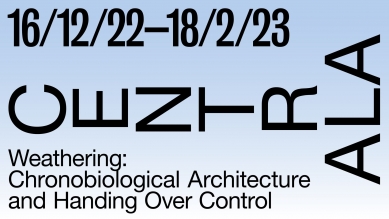
Weather influences: Chronobiological architecture and leaving things to themselves
Central Workshop in Gallery VI PER
Source
Galerie VI PER
Galerie VI PER
Publisher
Tisková zpráva
08.12.2022 12:50
Tisková zpráva
08.12.2022 12:50
Exhibitions
Czech Republic
Prague
Karlín
Atmospheric phenomena are recorded in buildings. Designing architecture so that it can age due to weather influences represents an aesthetic deviation from the illusion of constant novelty and the eternal sterility of modern materials. Places that face weather conditions blur the boundaries between the exterior and the interior. Bubbles form, pores and cracks open, accumulating fine debris, delicate dead organic matter brought by wind and rain. With this sediment comes spontaneously growing greenery, windborne organisms settle, and various animals climb over the irregularities. Burrows, cavities, cocoons, and nests emerge, creating new microenvironments. Weather influences free buildings from our illusory control and help them tune into the rhythm of nature.
Małgorzata Kuciewicz and Simone De Iacobis from the CENTRALA studio believe in chronobiological architecture, namely, its biological rhythms, architecture that creates and strengthens the feeling that we are part of the rhythm of day and night, the seasons, and other planetary and weather phenomena. They do not perceive the influence of weather as degeneration, but as the beginning of regeneration, as the return of matter back into the cycle of life.
In the VI PER gallery, the architects will present the results of their recent work. They explore architectural tools that can serve the understanding and design of various microclimates. They inquire about our openness to discomfort. They delve into the linguistic and formal richness of wetlands, the ancient yet forgotten relationship between architecture and aquatic vegetation, and the potential hidden in abandoning the Vitruvian principle of firmitas (durability) and detaching architecture from solid and established foundations.
CENTRALA is a Warsaw-based architectural research studio that focuses on reinterpretations and spatial interventions aimed at restoring the language of architecture. In their projects, they concentrate on the relationship between architecture and natural phenomena, approaching architecture as a process; they consider gravity, the water cycle, and atmospheric and astronomical phenomena as building materials.
CENTRALA is interested in the memory and materiality of architecture and stimulates public debate on the preservation of post-war architectural heritage. They learn from the legacy of Warsaw architects (including Zofia and Oskar Hansen, Viola and Jacek Damięcki, or Alina Scholtz) and revive forgotten architectural knowledge: the practices of Polish exhibition designs from the 1950s and 1960s, a shared vocabulary of post-war modernism, or the use of aquatic vegetation in architecture.
CENTRALA's work has been presented at a number of solo exhibitions: at the Polish Pavilion at the Venice Architecture Biennale in 2018, and in 2020 at the Concéntrico architecture and design festival in Logroño. As exhibition designers, they have collaborated with several European museums, galleries, and other institutions, including the Polish Pavilion at the Milan Triennale in 2016. Together with Alicja Bielawska and Aleksandra Kędziorek, they represented Poland at the London Design Biennale in 2021 with the exhibition The Clothed Home, which was repeated in 2022 at the National Museum in Kraków and at the Lisbon Architecture Triennale.
Małgorzata Kuciewicz and Simone De Iacobis from the CENTRALA studio believe in chronobiological architecture, namely, its biological rhythms, architecture that creates and strengthens the feeling that we are part of the rhythm of day and night, the seasons, and other planetary and weather phenomena. They do not perceive the influence of weather as degeneration, but as the beginning of regeneration, as the return of matter back into the cycle of life.
In the VI PER gallery, the architects will present the results of their recent work. They explore architectural tools that can serve the understanding and design of various microclimates. They inquire about our openness to discomfort. They delve into the linguistic and formal richness of wetlands, the ancient yet forgotten relationship between architecture and aquatic vegetation, and the potential hidden in abandoning the Vitruvian principle of firmitas (durability) and detaching architecture from solid and established foundations.
CENTRALA is a Warsaw-based architectural research studio that focuses on reinterpretations and spatial interventions aimed at restoring the language of architecture. In their projects, they concentrate on the relationship between architecture and natural phenomena, approaching architecture as a process; they consider gravity, the water cycle, and atmospheric and astronomical phenomena as building materials.
CENTRALA is interested in the memory and materiality of architecture and stimulates public debate on the preservation of post-war architectural heritage. They learn from the legacy of Warsaw architects (including Zofia and Oskar Hansen, Viola and Jacek Damięcki, or Alina Scholtz) and revive forgotten architectural knowledge: the practices of Polish exhibition designs from the 1950s and 1960s, a shared vocabulary of post-war modernism, or the use of aquatic vegetation in architecture.
CENTRALA's work has been presented at a number of solo exhibitions: at the Polish Pavilion at the Venice Architecture Biennale in 2018, and in 2020 at the Concéntrico architecture and design festival in Logroño. As exhibition designers, they have collaborated with several European museums, galleries, and other institutions, including the Polish Pavilion at the Milan Triennale in 2016. Together with Alicja Bielawska and Aleksandra Kędziorek, they represented Poland at the London Design Biennale in 2021 with the exhibition The Clothed Home, which was repeated in 2022 at the National Museum in Kraków and at the Lisbon Architecture Triennale.
The English translation is powered by AI tool. Switch to Czech to view the original text source.


0 comments
add comment










